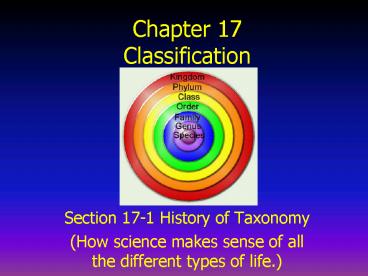Chapter 17 Classification - PowerPoint PPT Presentation
1 / 33
Title:
Chapter 17 Classification
Description:
Taxonomy organizes the huge biodiversity (variety of types of life) of the planet ... Ex: venus fly trap oak tree. Kingdom animalia. Multicellular. Eukaryotic ... – PowerPoint PPT presentation
Number of Views:48
Avg rating:3.0/5.0
Title: Chapter 17 Classification
1
Chapter 17Classification
- Section 17-1 History of Taxonomy
- (How science makes sense of all the different
types of life.)
2
Taxonomy is the branch of biology that names
organisms according to their characteristics and
evolutionary history
3
Taxonomy organizes the huge biodiversity (variety
of types of life) of the planet
4
Your task
You are going to be given several shapes. First
Determine a logical basis to separate the shapes
into 2 major groups or classifications. Arrange
your groups on your desk.
5
Task
Second Separate each group into 2 or 3 smaller
groups. Discuss with your table partner what
characteristics you based your classifications
on? Did your partner use the same
characteristics? If not scientifically argue the
merits of your decision.
6
Task
Third Separate each of your smaller groups into
even smaller groups. Discuss with your table
partner what characteristics you based your
classifications on? Did your partner use the
same characteristics? If not scientifically argue
the merits of your decision.
7
Summary
Discussion How is this activity like the
classification of living things? How is it
different? WRITE THIS QUESTION DOWN ON YOUR NOTES
AND ANSWER IT What information and observations
do scientists use to classify organisms?
(answer will be in these notes! Yay)
8
- Organisms were first classified by Aristotle over
2000 yrs ago! - His system classified organisms as either plant
or animal. - Problems with his classification
- Some organisms are neither plant or animal
- Common names are different in different regions
(ex. Puma, cougar, and mountain lion are all same
animal - Some common names are
- inaccurate (ex. Jellyfish is not a
- fish, seahorse is not a horse)
9
Carolus Linnaeus developed a more organized
system of classification in the 1700s
- This system involves seven levels of
classification which are still used today
10
Levels of classification
- Memory device
- King
- Phillip
- Came
- Over
- For
- Good
- Spices
- Kingdom
- Phylum
- Class
- Order
- Family
- Genus
- Species
11
Some examples (pg. 338)
12
Some examples (pg. 338)
13
Linnaeuss system for naming
- The system is known as binomial nomenclature (bi-
means 2) - Each species is identified by two names genus
and species. - Genus is capitalized the species is not and both
are written in italics - Ex Lynx rufus and Homo sapiens
14
(No Transcript)
15
Section 17-2 Modern Phylogenetic Taxonomy
16
- Classification originally based on morphology
- Modern taxonomists use this and other evidence to
place organisms on a phylogenetic tree - A phylogenetic tree is a diagram showing
evolutionary relationships of organisms
17
(No Transcript)
18
(No Transcript)
19
4 Types of Evidence Help Scientists make a
Phylogenetic Tree
20
Evidence
- Morphology, or the appearance of an organism.
Related organisms will share homologous
structures
21
Evidence
- 2. The fossil record
- Some fossils serve as links in connecting
current groups of organisms. - EX archaeopteryx
22
Evidence
- 3. Embryological patterns of development
- By looking at the stages of an organisms
development scientists can see patterns. - Ex all fertilized animal eggs begin to grow in
the same way - Zygote ? blastula ? gastrula (read pg 344)
23
Evidence
- Comparing the number of differences in DNA, amino
acids and proteins - If mutations in sequence occur regularly
scientists can predict how closely related
organisms are. The more similar the DNA the more
closely related the species.
24
Cladistics
- A new system of phylogenetic classification.
- It uses a shared derived characteristic to
establish relationships - Ex amniotic (shelled) egg separates reptiles and
birds from other organisms or hair on mammal
25
How to read a cladogram
Everything else has jaws
No jaws
26
Section 17-3 Two Modern Systems of Classification
27
Two main systemsThree Domain and Six Kingdom
28
Kingdom Archeabacteria
- Unicellular (one-celled)
- Prokaryotic (no nucleus)
- Chemosynthetic (use
- chemicals to make energy)
- They have different cell membranes than other
organisms - They often live in harsh environments
29
Kingdom Eubacteria
- Unicellular
- Prokaryotic
- Most use oxygen for
- respiration
- These are true bacteria involved in decomposing
dead animals and plants, making yogurt, etc.
30
Kingdom Protista
- Unicellular
- Eukaryotic (has nucleus)
- Can be autotrophic (make food or heterotrophic
(eat food) - Although in the same kingdom there is a huge
variety all very distantly related
Ex amoeba and euglena
31
Kingdom Fungi
- Multicellular AND UNICELLULAR!
- Eukaryotic
- They are heterotrophic (eat food) specifically
they absorb food. - Cell walls have chitin
- Common fungi Yeast mushrooms
32
Kingdom Plantae
- Multicellular
- Eukaryotic
- Autotrophic - Plants use solar energy to
photosynthesize or make food - Cell walls made of cellulose
- Ex venus fly trap oak tree
33
Kingdom animalia
- Multicellular
- Eukaryotic
- Heterotrophic (eat food)
- Can live on land or water.
- Ex. Coral elephant































